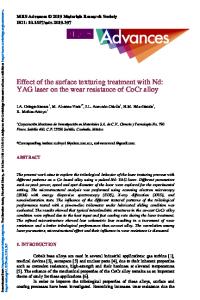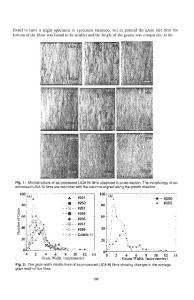Effect of annealing treatment on the microstructures, mechanical, and wear properties of a manganese brass alloy
- PDF / 1,051,263 Bytes
- 10 Pages / 584.957 x 782.986 pts Page_size
- 93 Downloads / 355 Views
Quanye Zhang Luzhou Changjiang Machinery Co. Ltd, Luzhou 646000, Sichuan, China
Tingju Li School of Material Science and Engineering, Dalian University of Technology, Dalian 116024, Liaoning, China (Received 27 November 2015; accepted 21 March 2016)
The effect of annealing treatment on the microstructures, mechanical, and wear properties of a CuZnAlMnSiNiCr brass alloy is investigated. The results indicate that nanosized Mn5Si3 particles are observed to precipitate from the b phase at temperatures above 750 °C. After annealing at 800 °C for 4 h, the formation of finely, coherent precipitates dispersed within the matrix results in the great improvement of strength, hardness and thus the high wear resistance, which can be proven by the decreased wear rates and friction coefficients. According to the examination of the wear topography, adhesive, abrasive, and oxidative wear are found to be the major wear forms during the dry sliding wear. After the precipitation-hardening treatment, the adhesion and abrasion decrease, and few spallings and cracks are observed on the worn surfaces. In addition, the wear behavior of the alloy is found to be strongly dependent on its strength and hardness.
I. INTRODUCTION
Brass, as one category of the most important copper alloys, is widely used in many fields of national economy like radiator, valves and pipes, due to its excellent combination of low cost and high comprehensive properties, including outstanding corrosion resistance, good formability, and suitable strength.1,2 Special brasses containing alloying elements such as aluminum, silicon, iron, manganese, and tin further possess high-strength and high wear resistance. Therefore, they are commonly used in the friction parts of machines, such as bearings, synchronizer rings, high-speed hydraulic rotors and so on.3–6 The alloying additions usually strengthen the brasses by entering into solid solution or forming intermetallic compounds in the microstructure. In the case of the brasses containing additions of Mn and Si, particles of manganese silicide are formed, which is indicated to be Mn5Si3.7 The Mn5Si3 particles have a high hardness and effectively improve the mechanical and wear properties, as it is demonstrated that dispersed hard particles in a relatively ductile matrix form an ideal structure for wear-resistant materials.8,9 During the past decades, the wear behaviors of special brasses were investigated under various wear test Contributing Editor: Jürgen Eckert a) Address all correspondence to this author. e-mail: [email protected] DOI: 10.1557/jmr.2016.136
conditions.3–6,10,11 However, for the brasses containing Mn and Si, few researches5,7 are available studying the effect of heat treatment on the microstructures and properties. Waheed et al. found that the wear of the special brasses was influenced by the volume fraction of a phase, which can be varied by the heating temperature.5 Sun et al. observed a great amount of nanosized Mn5Si3 precipitates in the microstructure of C67400 brass alloy after quenching at temperatu
Data Loading...











